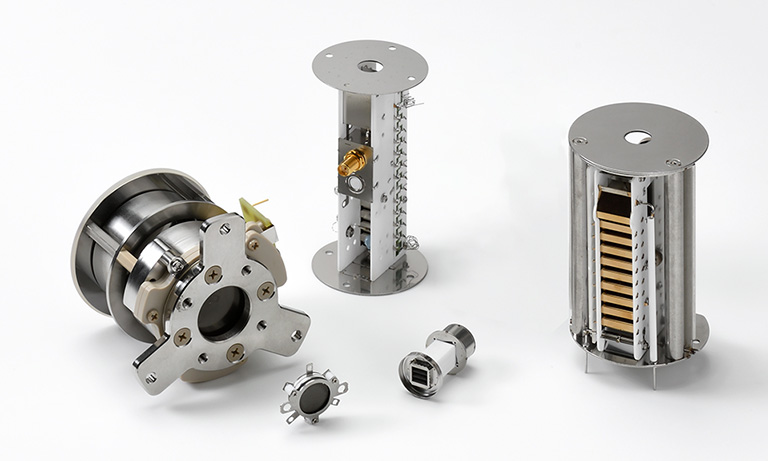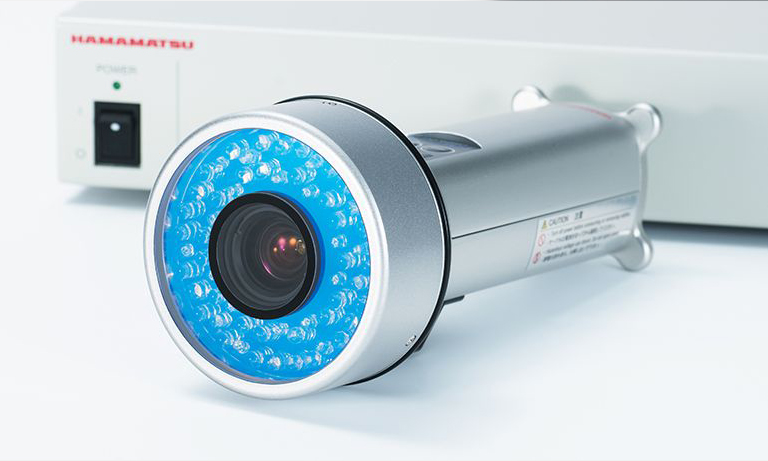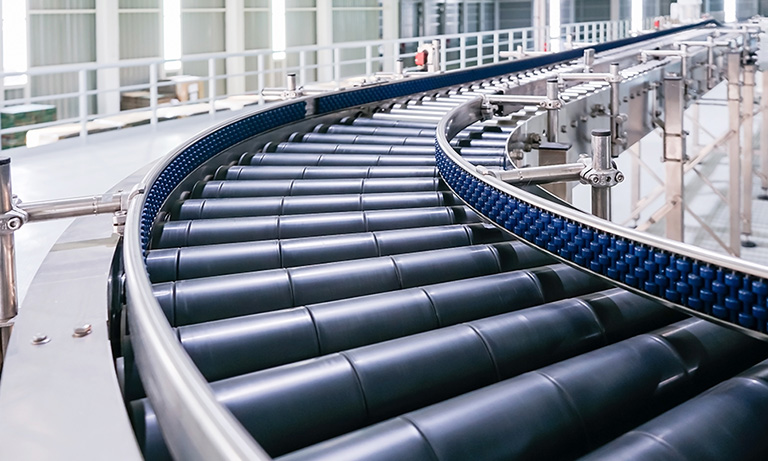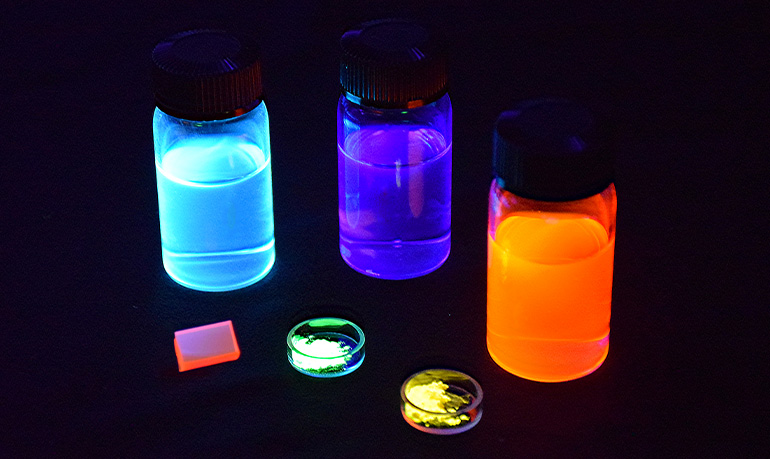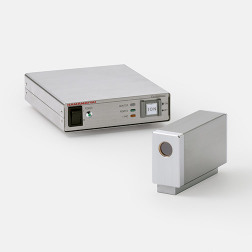Japan (EN)
Select your region or country.
PhotoIonizer
L12645
The PhotoIonizer is a completely new type of electrostatic remover using "photoionization" for clean, easy, yet effective generation of ions. The PhotoIonizer provides big advantages over the corona discharge method which is generally used.
Principle of operation
The PhotoIonizer is a completely new type of electrostatic remover using "photoionization" for clean, easy, yet effective generation of ions.
The PhotoIonizer provides big advantages over the corona discharge method which is generally used.The PhotoIonizer throughly ionizes molecules near the charged object so these ions in turn work effectively to remove electrostatic charges accumulated on the object.
The PhotoIonizer is certain to be the next generation of electrostatic charge removers, since it now eliminates all the problems conventional electrostatic removers have in terms of object, speed, environment and reliability.
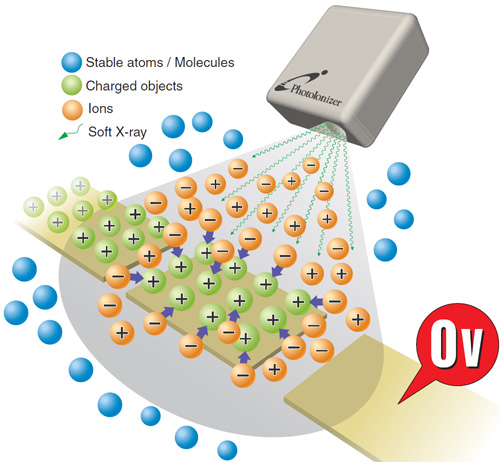
Features
No air flow
Ion generation constantly occurs over the entire volume exposed to soft X-rays. Ions generated near the charged object serve to effectively remove the electrostatic charge, so there is no need for sending generated ions toward the object by an air flow. The PhotoIonizer also removes electrostatic charges from lightweight parts and powder.
High ion density
In the corona discharge method, ions are mainly generated only near the electrodes. In the soft Xray method, however, ions are generated over the entire volume exposed to these soft X-rays, yielding a drastic improvement in the removal of electrostatic charges.
No overshoot
If ion generation balance is poor, the positive or the negative ions will continuously increase in large quantities, resulting in "overshoot" (generation of static charges of opposite polarity). The PhotoIonizer, however, simultaneously generates the same amount of "positive" and "negative" ions in an ideal balance that prevents overshoot.
No cleaning of electrodes required
Requires NO periodic maintenance usually needed on ordinary corona discharge ionizers.
No ozone generation
Ozone is generated when the air is exposed to specific types of UV rays (approx. 10 eV). The blue light of a corona discharge contains this type of UV ray. The PhotoIonizer, in contrast, emits soft X-rays (3 keV to 9.5 keV) into the air to make an ionization. This ion generation method does not generate any ozone.
No dust particles and electromagnetic noise generation
In the corona discharge method, microparticles in the air are attracted to the electrodes and then diffuse back as dust particles. Corona discharge accompanies the generation of electromagnetic noise. As long as the discharge method is used, the above problems are inevitable. In contrast, the soft X-ray method used by the PhotoIonizer eliminates these problems.
Compact
30 mm x 50 mm x 96 mm (W x H x D) [head]
About one-half the size of previous model. Installs even in narrow spaces.
Worldwide compatible power supply
Accepts 100 V to 240 V AC.
External control
15-pin D-sub connector.
Operates in two remote modes and provides 4 types of external outputs.
CE marking compliance
The PhotoIonizer complies with CE marking requirements therefore can be used in Europe.
Static charge removal performance
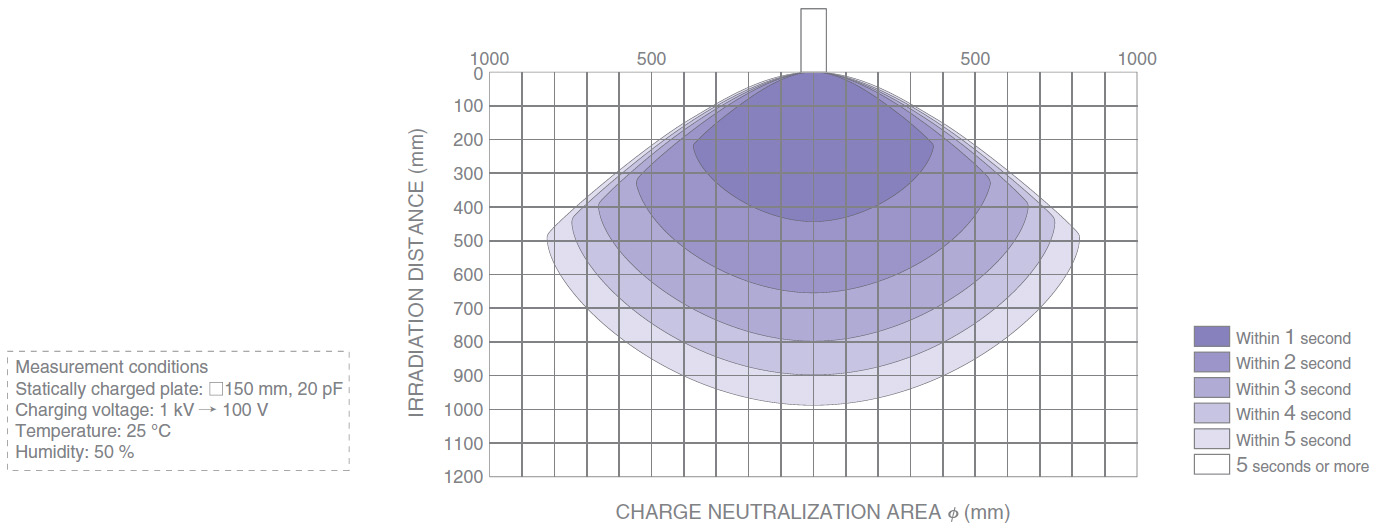
Specifications
| Parameter | Discription / Value | Unit | |
|---|---|---|---|
| Soft X-ray tube | Tube voltage (DC) | 9.5 | kV |
| X-ray emission angle | 130 | ° | |
| Input voltage | AC100 V to AC240 V, Single phase 50 Hz / 60 Hz | - | |
| Power consumption (Max.) | 11 | W | |
| Operating temperature range | 0 to +40 | ℃ | |
| Storage temperature range | -10 to +60 | ℃ | |
| Operating humidity range | Below 60 % (no condensation) | - | |
| Storage humidity range | Below 85 % (no condensation) | - | |
| External control | Ion ON/OFF control, Ion ON signal output, Error signals | - | |
| Applicable standards | EMC | IEC 61326-1:2013, Group 1, Class A | - |
| Safety | IEC61010-1:2010 | - | |
| Environment | RoHS directive, WEEE directive | - | |
Dimensional outline (Unit mm)
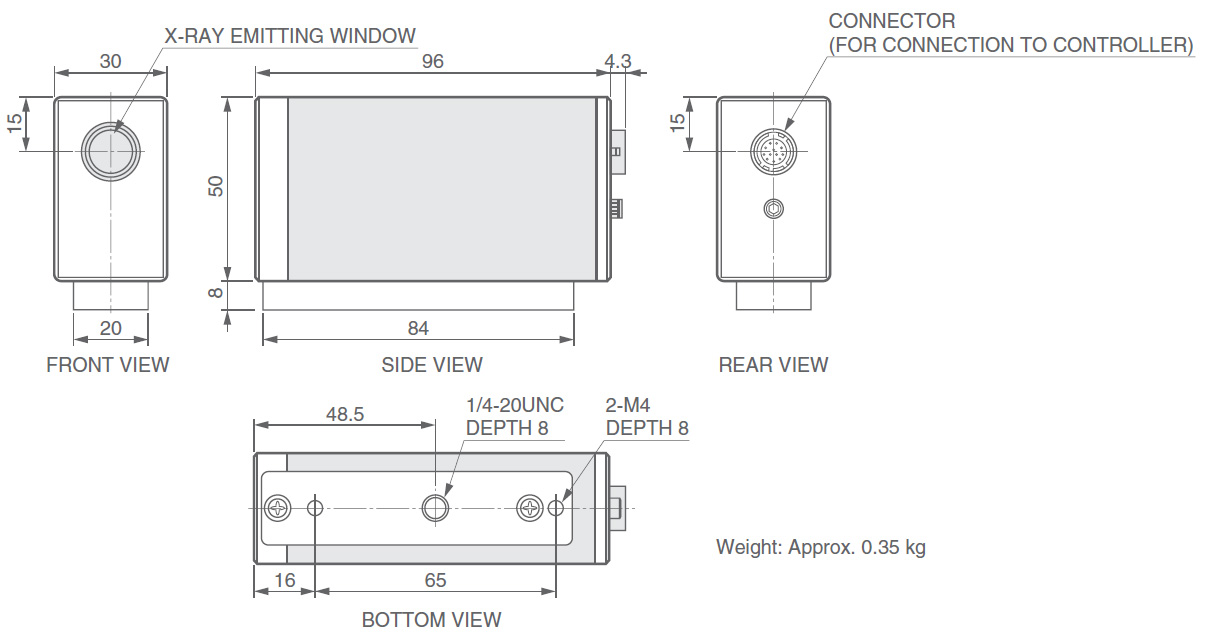

Options
Four-head controller C11952
The C11952 controller is capable of controlling up to 4 PhotoIonizer heads (L9491) at the same time. It is ideal for removing static charges from large objects with large surface areas or for using multiple heads on multiple production lines.
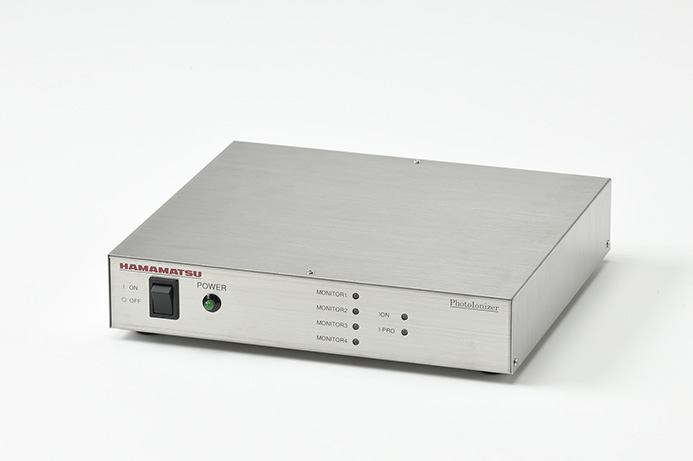
- Confirmation
-
It looks like you're in the . If this is not your location, please select the correct region or country below.
You're headed to Hamamatsu Photonics website for JP (English). If you want to view an other country's site, the optimized information will be provided by selecting options below.
In order to use this website comfortably, we use cookies. For cookie details please see our cookie policy.
- Cookie Policy
-
This website or its third-party tools use cookies, which are necessary to its functioning and required to achieve the purposes illustrated in this cookie policy. By closing the cookie warning banner, scrolling the page, clicking a link or continuing to browse otherwise, you agree to the use of cookies.
Hamamatsu uses cookies in order to enhance your experience on our website and ensure that our website functions.
You can visit this page at any time to learn more about cookies, get the most up to date information on how we use cookies and manage your cookie settings. We will not use cookies for any purpose other than the ones stated, but please note that we reserve the right to update our cookies.
1. What are cookies?
For modern websites to work according to visitor’s expectations, they need to collect certain basic information about visitors. To do this, a site will create small text files which are placed on visitor’s devices (computer or mobile) - these files are known as cookies when you access a website. Cookies are used in order to make websites function and work efficiently. Cookies are uniquely assigned to each visitor and can only be read by a web server in the domain that issued the cookie to the visitor. Cookies cannot be used to run programs or deliver viruses to a visitor’s device.
Cookies do various jobs which make the visitor’s experience of the internet much smoother and more interactive. For instance, cookies are used to remember the visitor’s preferences on sites they visit often, to remember language preference and to help navigate between pages more efficiently. Much, though not all, of the data collected is anonymous, though some of it is designed to detect browsing patterns and approximate geographical location to improve the visitor experience.
Certain type of cookies may require the data subject’s consent before storing them on the computer.
2. What are the different types of cookies?
This website uses two types of cookies:
- First party cookies. For our website, the first party cookies are controlled and maintained by Hamamatsu. No other parties have access to these cookies.
- Third party cookies. These cookies are implemented by organizations outside Hamamatsu. We do not have access to the data in these cookies, but we use these cookies to improve the overall website experience.
3. How do we use cookies?
This website uses cookies for following purposes:
- Certain cookies are necessary for our website to function. These are strictly necessary cookies and are required to enable website access, support navigation or provide relevant content. These cookies direct you to the correct region or country, and support security and ecommerce. Strictly necessary cookies also enforce your privacy preferences. Without these strictly necessary cookies, much of our website will not function.
- Analytics cookies are used to track website usage. This data enables us to improve our website usability, performance and website administration. In our analytics cookies, we do not store any personal identifying information.
- Functionality cookies. These are used to recognize you when you return to our website. This enables us to personalize our content for you, greet you by name and remember your preferences (for example, your choice of language or region).
- These cookies record your visit to our website, the pages you have visited and the links you have followed. We will use this information to make our website and the advertising displayed on it more relevant to your interests. We may also share this information with third parties for this purpose.
Cookies help us help you. Through the use of cookies, we learn what is important to our visitors and we develop and enhance website content and functionality to support your experience. Much of our website can be accessed if cookies are disabled, however certain website functions may not work. And, we believe your current and future visits will be enhanced if cookies are enabled.
4. Which cookies do we use?
There are two ways to manage cookie preferences.
- You can set your cookie preferences on your device or in your browser.
- You can set your cookie preferences at the website level.
If you don’t want to receive cookies, you can modify your browser so that it notifies you when cookies are sent to it or you can refuse cookies altogether. You can also delete cookies that have already been set.
If you wish to restrict or block web browser cookies which are set on your device then you can do this through your browser settings; the Help function within your browser should tell you how. Alternatively, you may wish to visit www.aboutcookies.org, which contains comprehensive information on how to do this on a wide variety of desktop browsers.
5. What are Internet tags and how do we use them with cookies?
Occasionally, we may use internet tags (also known as action tags, single-pixel GIFs, clear GIFs, invisible GIFs and 1-by-1 GIFs) at this site and may deploy these tags/cookies through a third-party advertising partner or a web analytical service partner which may be located and store the respective information (including your IP-address) in a foreign country. These tags/cookies are placed on both online advertisements that bring users to this site and on different pages of this site. We use this technology to measure the visitors' responses to our sites and the effectiveness of our advertising campaigns (including how many times a page is opened and which information is consulted) as well as to evaluate your use of this website. The third-party partner or the web analytical service partner may be able to collect data about visitors to our and other sites because of these internet tags/cookies, may compose reports regarding the website’s activity for us and may provide further services which are related to the use of the website and the internet. They may provide such information to other parties if there is a legal requirement that they do so, or if they hire the other parties to process information on their behalf.
If you would like more information about web tags and cookies associated with on-line advertising or to opt-out of third-party collection of this information, please visit the Network Advertising Initiative website http://www.networkadvertising.org.
6. Analytics and Advertisement Cookies
We use third-party cookies (such as Google Analytics) to track visitors on our website, to get reports about how visitors use the website and to inform, optimize and serve ads based on someone's past visits to our website.
You may opt-out of Google Analytics cookies by the websites provided by Google:
https://tools.google.com/dlpage/gaoptout?hl=en
As provided in this Privacy Policy (Article 5), you can learn more about opt-out cookies by the website provided by Network Advertising Initiative:
http://www.networkadvertising.org
We inform you that in such case you will not be able to wholly use all functions of our website.
Close











